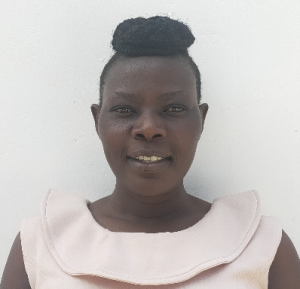"The community is facing a great challenge in matters concerning water," said our field officer Joyce Naliaka when describing the water situation for the 280 people who live in Khabondi Community.
The community relies on a spring that, at first glance, might seem protected, but it is not properly constructed, and this creates a couple of significant issues that need to be addressed for people to access safe drinking water.

Water is streaming from the collection pipe at a slow discharge rate, so people are wasting their valuable time waiting in long lines. This leads to overcrowding in the spring, increasing everyone's frustration levels. The time they lose is time they need to accomplish other vital daily tasks, and everyone's everyday life suffers from wasting time waiting to collect water.

"Personally, this situation has affected my daily schedule because most of the time has been directed to fetching water; hence this current situation has turned into a nuisance due to time wastage," shared 36-year-old farmer Emmaculate Mukabwa (shown above).
"The water situation has come between me and my personal study time. Because of the urgent need for water most of the time after school, I am forced to fetch water for our household. This activity usually takes a lot of time because of the long queue normally witnessed at the spring," said 7-year-old Dina.

Another vital issue is that the water people manage to collect is not filtered correctly; therefore, it is unsafe for human consumption. However, without another alternative source, people take their chances and drink the water anyway, often foregoing the suggested chlorine to treat the water.
When interviewing those in the community, Joyce was unsurprised to hear that people have been struggling with their health. "The response I got regarding matters [of] health was that for the past few months, there has been an outbreak of typhoid cases in the community. This was reported in some of the households [that] rejected the use of chlorine for treating water."
When community members are sick with water-related illnesses, it further steals their health, energy, and productivity, which they need to improve their daily lives.
The spring must be rebuilt entirely so the layers required to filter the water can be added. The spring box can be reconstructed to ensure the best water flow from the collection pipe, and that the water will drain adequately so, no one has to stand in stagnant water. And adding stairs will make it easier for people to access the water without falling.
With proper protection, this spring can be the water source that the community needs so that people can quickly and efficiently collect safe water to consume and return to doing the other vital things they need to do to improve their lives.
The Proposed Solution, Determined Together...
At The Water Project, everyone has a part in conversations and solutions. We operate in transparency, believing it benefits everyone. We expect reliability from one another as well as our water solutions. Everyone involved makes this possible through hard work and dedication.
In a joint discovery process, community members determine their most advantageous water solution alongside our technical experts. Read more specifics about this solution on the What We're Building tab of this project page. Then, community members lend their support by collecting needed construction materials (sometimes for months ahead of time!), providing labor alongside our artisans, sheltering and feeding the builders, and supplying additional resources.
Water Access for Everyone
This water project is one piece in a large puzzle. In Kenya, Sierra Leone, and Uganda, we're working toward complete coverage of reliable, maintained water sources that guarantee public access now and in the future within a 30-minute round trip for each community, household, school, and health center. One day, we hope to report that this has been achieved!
Training on Health, Hygiene & More
With the community's input, we've identified topics where training will increase positive health outcomes at personal, household, and community levels. We'll coordinate with them to find the best training date. Some examples of what we train communities on are:
- Improved hygiene, health, and sanitation habits
- Safe water handling, storage & treatment
- Disease prevention and proper handwashing
- Income-generation
- Community leadership, governance, & election of a water committee
- Operation and maintenance of the water point
Chlorine Dispensers
Installing chlorine dispensers is an important piece of our spring protection projects. Protecting a spring provides community members with an improved water source, but it doesn’t prevent contamination once the water is collected and stored. For example, if the water is clean and the container is dirty, the water will become contaminated.
We ensure that each chlorine dispenser is filled with diluted chlorine on a consistent schedule so that people can add pre-measured drops to each container of water they collect. That way, community members can feel even more confident in the quality of their water.

 Protected Spring
Protected Spring
 Rehabilitation Project
Rehabilitation Project
















